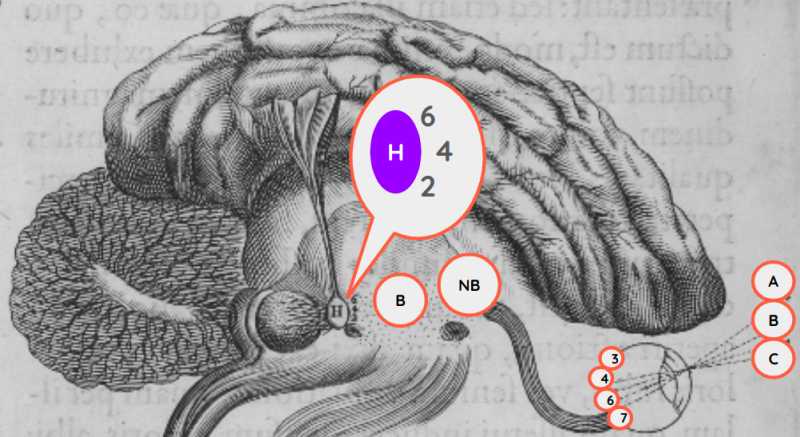How are Our Ideas Formed?
Table of Contents
30. How are our ideas of objects formed in the seat of imagination and common sense?
How are they preserved in memory? How do they stir the movement of all the limbs?
The spirits flow out from the pineal gland H from the area M after they have dilated the part of the brain marked A and all pores are opened.
They then withdraw from there to B, then to C, and finally towards D, from where they spread into all the nerves.

The nerves and the brain are composed of filaments which are so closely connected.
- Even actions of very slight force in moving are easily communicated from one end to the other.
The obliquity of the paths they traverse is not an impediment.
- That obliquity serves the formation of the ideas of objects which strike the senses.
The filaments 1, 2, 3, 4, 5, 6, and the like, compose the optic nerves.
- These are expanded from the bottom of the eye
1, 3, 5to the inner surface of the brain2, 4, 6.

These filaments are so arranged that if rays drawn, for example,
If the rays from point A press on the bottom of the eye at point i, they will:
- draw the entire filament
1, 2 - extend and open more the tube
2.
In exactly the same way, rays incident on point 3 open tube 4.
This applies to the others.
The points 1, 3, 5 are pressed differently by these rays.
- These then impress on the bottom of the eye a shape corresponding to object
A, B, C
The tubes 2, 4, 6 are open in various ways.
- These also imprint their trace on the inner surface of the brain through filaments
1, 2, 3, 4, 5, 6, etc.
31. How the spirits enter and exit the pineal gland
The spirits which try to enter each of the tubes 2, 4, 6 and similar ones of the pineal gland
not to come out indifferently from all points that are on the surface of gland H, but only from certain ones individually.

Those which come out from point A strive to enter tubes 4 and 6, and so on for the others.
As soon as the openings of those tubes become larger, the spirits from the surface of the pineal gland begin to exit more freely and quickly than before.
- They look towards those points on the tubes.
The different ways in which the tubes 2, 4, 6 are open impress a shape on the inner surface of the brain similar to the object ABC.
Likewise, those modes or determinations which arise from spirits flowing from points ABC imprint the same shape on the surface of the pineal gland.
“Shape” here means:
- those things which represent the determinations of lines and the surfaces of objects in a certain way
- those things which can make the soul perceive motion, distance, magnitude, colors, sounds, smells, and other similar qualities.
- These include those things that make the soul perceive tickling, pain, hunger, joy, sadness, or other similar passions.
For example, a tube might be opened in a different way by an action other than the one I mentioned.
This would then excite the sensation of red color or the sensation of tickling, instead of inducing the sensation of white color or that of pain.
The spirits flowing from point A tend to enter this tube in different ways depending on how it has been opened, and so on for the others.
But these shapes are not among those shapes inscribed on:
- the organs of external senses or
- the inner surface of the brain
The shapes are those which are affected by the spirits on the surface of the pineal gland H.
- The pineal gland is the seat of imagination and common sense.
These shapes are ideas.
- These are forms or images which the rational soul will consider immediately after this machine is united, when it imagines or feels some object.